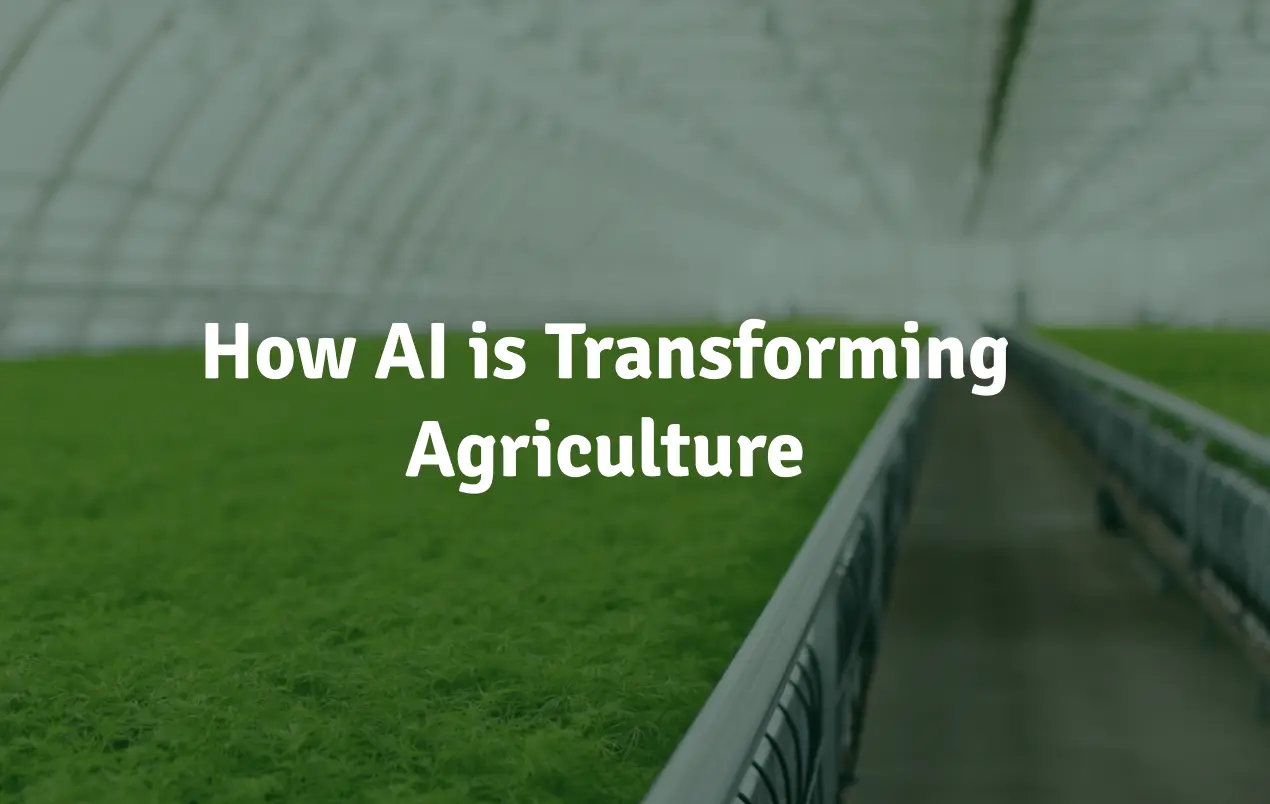



Introduction
Agriculture, one of the world’s oldest industries, is undergoing a high-tech transformation, driven by artificial intelligence (AI). As farmers face mounting pressures, like producing more plants, addressing climate change, and meeting higher sustainability standards, technology is emerging as a critical solution. AI, with its data analysis, automation, and prediction capabilities, offers an unprecedented opportunity to tackle these challenges head-on. In this post, we'll explore how AI is revolutionizing agriculture and what it means for its future.
Why AI in Agriculture?
The Modern Challenges
Today, agriculture must contend with some significant issues. Farmers are under pressure to produce more plants while using fewer resources. Climate change brings unpredictable weather, pests, and diseases that threaten crops. Labor shortages add to the difficulties, as traditional, manual farming requires intensive human effort. Additionally, there is a push for more sustainable practices to preserve the environment and maintain soil health for future generations.
Why Traditional Methods Fall Short
While traditional farming techniques have worked for centuries, they can be inefficient and lack the precision needed in modern agriculture, and the unpredictable nature of farming demands faster, more informed decision-making. Here, AI steps in as a transformative tool, providing farmers with actionable insights, early warnings, and automation that improve efficiency and productivity.
Applications of AI in Agriculture
1. Crop Monitoring and Prediction
AI is changing the game in crop monitoring by using satellite imagery, drones, and sensors to assess crop health in real time. These tools collect vast amounts of data, ranging from moisture levels to disease markers, allowing AI algorithms to spot trends and predict yields. For instance, AI models can analyze images to detect subtle changes in plant color or texture, signs of diseases, or nutrient deficiencies that are hard to spot with the naked eye. Through predictive analytics, farmers can forecast potential yield, manage risks, and optimize their harvesting schedules.
2. Disease and Pest Detection
Diseases and pests are significant threats to crop health and yields. Fortunately, AI, combined with image recognition technology, enables farmers to detect diseases at an early stage, often before they spread. Machine learning algorithms can scan images of plants to identify symptoms of specific diseases, pests, or nutrient deficiencies. Several AI-powered platforms and mobile applications now allow farmers to snap a picture of their plants and receive instant feedback, making disease detection efficient and accessible.
3. Precision Agriculture
Precision agriculture uses AI to tailor farming practices to the specific needs of different parts of a field or a greenhouse. Rather than applying the same amount of water, fertilizer, and pesticides everywhere, AI-powered systems analyze soil, weather, and crop data to make recommendations on a smaller scale. This targeted approach minimizes waste and maximizes resource efficiency, leading to healthier crops and a reduced environmental impact. By using AI to optimize inputs, farmers can save costs while producing better yields.
4. Automation and Robotics
AI-driven robots are changing the landscape of agriculture by automating labor-intensive tasks like planting, watering, and harvesting. These robots come in various forms, from autonomous tractors and weeding robots to fruit-picking machines. Drones equipped with AI can map fields, monitor crop growth, and even apply pesticides or water to specific areas. With labor shortages as a persistent issue, agricultural robots are becoming a valuable asset for farmers, increasing efficiency and reducing the need for human labor in repetitive tasks.
Benefits of AI in Agriculture
1. Increased Efficiency
AI streamlines farming by automating data collection and analysis, speeding up decision-making processes. Where farmers once relied on manual observations and guesswork, AI offers precise, real-time insights. Automation reduces human error and boosts productivity, allowing farmers to manage their operations more effectively.
2. Sustainability and Environmental Impact
Sustainable practices are essential for the future of farming. AI enables farmers to reduce resource use and minimize environmental impact by applying inputs more precisely. For example, AI-driven irrigation systems use just the right amount of water based on soil moisture data, preventing water waste. Similarly, precision spraying minimizes the use of pesticides, lowering chemical runoff into soil and waterways.
3. Improved Yields and Profitability
With better disease detection, yield prediction, and resource optimization, farmers can produce higher yields with less input. Higher yields mean better profits, making farming a more sustainable livelihood, especially for smallholder farmers who operate with limited resources. By lowering costs and maximizing output, AI helps farmers run profitable and resilient operations.
4. Risk Mitigation
AI helps farmers manage risks related to crop failures, pests, and weather conditions. Predictive analytics allow them to anticipate challenges and act proactively, reducing losses. For instance, by predicting potential pest outbreaks or unfavorable weather, farmers can take preventative measures, to safeguard their crops.
Challenges and Limitations of AI in Agriculture
1. Cost and Accessibility
While AI offers enormous potential, implementing AI technologies can be expensive, especially for small and medium-sized farms. Advanced systems require significant initial investment in equipment, software, and skilled personnel, which can be a barrier for farmers with limited resources. Additionally, many rural areas lack the infrastructure needed for AI technology, such as high-speed internet, which limits its accessibility.
2. Data Privacy and Security
As AI in agriculture often relies on large volumes of data, including farm-specific data, satellite images, and even personal information from farmers, concerns about data privacy and security arise. Farmers need assurance that their data will be handled responsibly and not used against their interests. Building secure and transparent data policies is essential to ensure farmers' trust in AI technologies.
3. Technical and Ethical Concerns
Adopting AI requires technical expertise that many farmers may not have, leading to a skills gap. Some may feel intimidated by complex AI systems or lack the training to use them effectively. There are also ethical considerations, such as job displacement due to automation. As more tasks are handled by robots, concerns grow around the future of traditional farm jobs. Balancing technological advancements with social and ethical considerations is essential for sustainable AI adoption in agriculture.
Future of AI in Agriculture
1. Advances on the Horizon
The future of AI in agriculture holds incredible potential. As technology evolves, AI applications are becoming increasingly specialized, moving beyond traditional crop management to include tools that streamline various aspects of farm operations. From AI-driven drones that perform real-time crop assessments to smart greenhouses that automatically regulate optimal conditions, the horizon is filled with innovations designed to make agriculture more efficient and resilient. Combining AI with other emerging technologies, like IoT sensors, predictive analytics, and precision mapping, promises to enhance resource management and provide deeper insights into crop health, yield prediction, and risk management.
2. Active Example: The Zeraa Platform
One solution actively making strides in this direction is Zeraa, a platform designed specifically for plant management in nurseries. Zeraa leverages AI to address health monitoring in a unique, user-friendly way. It features a Kanban board that displays disease detections automatically generated by AI as tasks that users can track and manage. This setup enables nursery operators to respond promptly to potential disease outbreaks, allowing for rapid action and minimized spread.
In addition to disease management, Zeraa provides comprehensive statistics on crop health, plant distribution across areas, and insights into plant types, giving users a powerful tool to make informed decisions about their nursery operations. By combining real-time detection with insightful analytics, Zeraa offers a glimpse into how AI can empower agricultural professionals, helping them work more efficiently and anticipate needs.
Conclusion
The impact of AI on agriculture is undeniable and transformative. By automating labor, improving resource efficiency, and enabling proactive decision-making, AI is helping farmers tackle some of their biggest challenges and create a more sustainable, resilient food system. However, realizing the full potential of AI in agriculture requires addressing challenges around accessibility, infrastructure, and data ethics. As we look to the future, continued innovation and collaboration will be key to ensuring that AI empowers all farmers big and small to thrive in a changing world.
Whether you're a tech enthusiast, a farmer, or just interested in the future of agriculture, understanding AI’s role in agriculture is more important than ever. As these technologies continue to advance, they offer hope for a world where agriculture is not only more productive but also more sustainable and accessible to all.